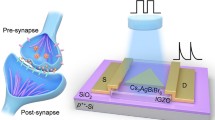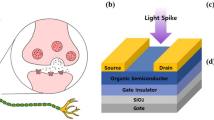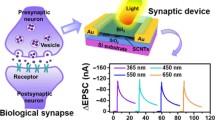Abstract
Photonic synaptic transistors are promising neuromorphic computing systems that are expected to circumvent the intrinsic limitations of von Neumann-based computation. The design and construction of photonic synaptic transistors with a facile fabrication process and high-efficiency information processing ability are highly desired, while it remains a tremendous challenge. Herein, a new approach based on spin coating of a blend of CsPbBr3 perovskite quantum dot (QD) and PDVT-10 conjugated polymer is reported for the fabrication of photonic synaptic transistors. The combination of flat surface, outstanding optical absorption, and remarkable charge transporting performance contributes to high-efficiency photon-to-electron conversion for such perovskite-based synapses. High-performance photonic synaptic transistors are thus fabricated with essential synaptic functionalities, including excitatory postsynaptic current (EPSC), paired-pulse facilitation (PPF), and long-term memory. By utilizing the photonic potentiation and electrical depression features, perovskite-based photonic synaptic transistors are also explored for neuromorphic computing simulations, showing high pattern recognition accuracy of up to 89.98%, which is one of the best values reported so far for synaptic transistors used in pattern recognition. This work provides an effective and convenient pathway for fabricating perovskite-based neuromorphic systems with high pattern recognition accuracy.

摘要
光突触晶体管被视为有潜力的神经形态计算系统, 有望克服基 于冯诺依曼架构运算的固有限制. 然而, 具备简单制备工艺和高效信息 处理能力的光突触晶体管的设计和构建面临着巨大的挑战. 本文报道 了一种通过旋涂CsPbBr3钙钛矿量子点(QDs)和PDVT-10共轭聚合物共 混物来制备光突触晶体管的新方法. 由CsPbBr3 QDs和PDVT-10组成的 杂化薄膜具有平坦的表面、优异的光吸收和良好的电荷传输性能, 有 助于此类钙钛矿基突触实现高效的光电转换. 因此, 基于CsPbBr3 QDs 和PDVT-10杂化薄膜的光突触晶体管表现出了优异的器件性能, 并具 有基本的突触功能, 包括兴奋性突触后电流、双脉冲促进和长程记忆. 通过利用光增强和电抑制特性, 基于钙钛矿的光突触晶体管被成功应 用于神经形态计算, 其模式识别精度高达89.98%, 这是迄今为止用于模 式识别的突触晶体管的最高值之一. 这项工作为制备高模式识别精度 的钙钛矿基神经形态系统提供了一条有效且方便的途径.
Similar content being viewed by others
References
Tang J, Yuan F, Shen X, et al. Bridging biological and artificial neural networks with emerging neuromorphic devices: Fundamentals, progress, and challenges. Adv Mater, 2019, 31: 1902761
Zidan MA, Strachan JP, Lu WD. The future of electronics based on memristive systems. Nat Electron, 2018, 1: 22–29
Jeong DS, Hwang CS. Nonvolatile memory materials for neuromorphic intelligent machines. Adv Mater, 2018, 30: 1704729
Liu C, Yan X, Song X, et al. A semi-floating gate memory based on van der Waals heterostructures for quasi-non-volatile applications. Nat Nanotech, 2018, 13: 404–410
Xu W, Cho H, Kim YH, et al. Organometal halide perovskite artificial synapses. Adv Mater, 2016, 28: 5916–5922
Liu Y, Zhong J, Li E, et al. Self-powered artificial synapses actuated by triboelectric nanogenerator. Nano Energy, 2019, 60: 377–384
Gao J, Zheng Y, Yu W, et al. Intrinsic polarization coupling in 2D α-In2Se3 toward artificial synapse with multimode operations. SmartMat, 2021, 2: 88–98
Pereda AE. Electrical synapses and their functional interactions with chemical synapses. Nat Rev Neurosci, 2014, 15: 250–263
Li E, Wu X, Chen Q, et al. Nanoscale channel organic ferroelectric synaptic transistor array for high recognition accuracy neuromorphic computing. Nano Energy, 2021, 85: 106010
Lv Z, Chen M, Qian F, et al. Mimicking neuroplasticity in a hybrid biopolymer transistor by dual modes modulation. Adv Funct Mater, 2019, 29: 1902374
Wang X, Li E, Liu Y, et al. Stretchable vertical organic transistors and their applications in neurologically systems. Nano Energy, 2021, 90: 106497
Feng G, Jiang J, Zhao Y, et al. A sub-10 nm vertical organic/inorganic hybrid transistor for pain-perceptual and sensitization-regulated nociceptor emulation. Adv Mater, 2020, 32: 1906171
Feng G, Jiang J, Li Y, et al. Flexible vertical photogating transistor network with an ultrashort channel for in-sensor visual nociceptor. Adv Funct Mater, 2021, 31: 2104327
Li Y, Yin K, Diao Y, et al. A biopolymer-gated ionotronic junctionless oxide transistor array for spatiotemporal pain-perception emulation in nociceptor network. Nanoscale, 2022, 14: 2316–2326
Qian C, Kong L, Yang J, et al. Multi-gate organic neuron transistors for spatiotemporal information processing. Appl Phys Lett, 2017, 110: 083302
Zhang Q, Jin T, Ye X, et al. Organic field effect transistor-based photonic synapses: Materials, devices, and applications. Adv Funct Mater, 2021, 31: 2106151
Ercan E, Lin YC, Yang WC, et al. Self-assembled nanostructures of quantum dot/conjugated polymer hybrids for photonic synaptic transistors with ultralow energy consumption and zero-gate bias. Adv Funct Mater, 2022, 32: 2107925
Chiang YC, Hung CC, Lin YC, et al. High-performance nonvolatile organic photonic transistor memory devices using conjugated rod-coil materials as a floating gate. Adv Mater, 2020, 32: 2002638
Lu K, Li X, Sun Q, et al. Solution-processed electronics for artificial synapses. Mater Horiz, 2021, 8: 447–470
Yang F, Sun L, Duan Q, et al. Vertical-organic-nanocrystal-arrays for crossbar memristors with tuning switching dynamics toward neuromorphic computing. SmartMat, 2021, 2: 99–108
Li Y, Zhang C, Shi Z, et al. Recent advances on crystalline materials-based flexible memristors for data storage and neuromorphic applications. Sci China Mater, 2022, 65: 2110–2127
He Y, Nie S, Liu R, et al. Spatiotemporal information processing emulated by multiterminal neuro-transistor networks. Adv Mater, 2019, 31: 1900903
Chen Y, Qiu W, Wang X, et al. Solar-blind SnO2 nanowire photosynapses for associative learning and coincidence detection. Nano Energy, 2019, 62: 393–400
Sun J, Oh S, Choi Y, et al. Optoelectronic synapse based on IGZO-alkylated graphene oxide hybrid structure. Adv Funct Mater, 2018, 28: 1804397
Gholipour B, Bastock P, Craig C, et al. Amorphous metal-sulphide microfibers enable photonic synapses for brain-like computing. Adv Opt Mater, 2015, 3: 635–641
Wu X, Li E, Liu Y, et al. Artificial multisensory integration nervous system with haptic and iconic perception behaviors. Nano Energy, 2021, 85: 106000
Chen T, Wang X, Hao D, et al. Photonic synapses with ultra-low energy consumption based on vertical organic field-effect transistors. Adv Opt Mater, 2021, 9: 2002030
Huang X, Li Q, Shi W, et al. Dual-mode learning of ambipolar synaptic phototransistor based on 2D perovskite/organic heterojunction for flexible color recognizable visual system. Small, 2021, 17: 2102820
Dai S, Wu X, Liu D, et al. Light-stimulated synaptic devices utilizing interfacial effect of organic field-effect transistors. ACS Appl Mater Interfaces, 2018, 10: 21472–21480
Zhong YN, Gao X, Xu JL, et al. Selective UV-gating organic mem-transistors with modulable levels of synaptic plasticity. Adv Electron Mater, 2020, 6: 1900955
Wang Y, Zhu Y, Li Y, et al. Dual-modal optoelectronic synaptic devices with versatile synaptic plasticity. Adv Funct Mater, 2022, 32: 2107973
Wang Y, Yin L, Huang W, et al. Optoelectronic synaptic devices for neuromorphic computing. Adv Intelligent Syst, 2021, 3: 2000099
Li X, Wu Y, Zhang S, et al. CsPbX3 quantum dots for lighting and displays: Room-temperature synthesis, photoluminescence superiorities, underlying origins and white light-emitting diodes. Adv Funct Mater, 2016, 26: 2435–2445
Wang K, Dai S, Zhao Y, et al. Light-stimulated synaptic transistors fabricated by a facile solution process based on inorganic perovskite quantum dots and organic semiconductors. Small, 2019, 15: 1900010
He W, Fang Y, Yang H, et al. A multi-input light-stimulated synaptic transistor for complex neuromorphic computing. J Mater Chem C, 2019, 7: 12523–12531
Cheng Y, Shan K, Xu Y, et al. Hardware implementation of photoelectrically modulated dendritic arithmetic and spike-timing-dependent plasticity enabled by an ion-coupling gate-tunable vertical 0D-perovskite/2D-MoS2 hybrid-dimensional van der Waals heterostructure. Nanoscale, 2020, 12: 21798–21811
Zhou S, Zhou G, Li Y, et al. Understanding charge transport in allinorganic halide perovskite nanocrystal thin-film field effect transistors. ACS Energy Lett, 2020, 5: 2614–2623
Zhou S, Ma Y, Zhou G, et al. Ag-doped halide perovskite nanocrystals for tunable band structure and efficient charge transport. ACS Energy Lett, 2019, 4: 534–541
Li X, Wang Y, Sun H, et al. Amino-mediated anchoring perovskite quantum dots for stable and low-threshold random lasing. Adv Mater, 2017, 29: 1701185
Liu K, Bian Y, Kuang J, et al. Ultrahigh-performance optoelectronic skin based on intrinsically stretchable perovskite-polymer heterojunction transistors. Adv Mater, 2022, 34: 2107304
Hao D, Zhang J, Dai S, et al. Perovskite/organic semiconductor-based photonic synaptic transistor for artificial visual system. ACS Appl Mater Interfaces, 2020, 12: 39487–39495
Chen Y, Chu Y, Wu X, et al. High-performance inorganic perovskite quantum dot-organic semiconductor hybrid phototransistors. Adv Mater, 2017, 29: 1704062
Wang Y, Lv Z, Chen J, et al. Photonic synapses based on inorganic perovskite quantum dots for neuromorphic computing. Adv Mater, 2018, 30: 1802883
Chen JY, Yang DL, Jhuang FC, et al. Ultrafast responsive and low-energy-consumption poly(3-hexylthiophene)/perovskite quantum dots composite film-based photonic synapse. Adv Funct Mater, 2021, 31: 2105911
Li L, Wang XL, Pei J, et al. Floating-gate photosensitive synaptic transistors with tunable functions for neuromorphic computing. Sci China Mater, 2021, 64: 1219–1229
Shi Q, Liu D, Hao D, et al. Printable, ultralow-power ternary synaptic transistors for multifunctional information processing system. Nano Energy, 2021, 87: 106197
Protesescu L, Yakunin S, Bodnarchuk MI, et al. Nanocrystals of cesium lead halide perovskites (CsPbX3, X = Cl, Br, and I): Novel optoelectronic materials showing bright emission with wide color gamut. Nano Lett, 2015, 15: 3692–3696
Chen H, Guo Y, Yu G, et al. Highly π-extended copolymers with diketopyrrolopyrrole moieties for high-performance field-effect transistors. Adv Mater, 2012, 24: 4618–4622
Yi Z, Wang S, Liu Y. Design of high-mobility diketopyrrolopyrrole-based π-conjugated copolymers for organic thin-film transistors. Adv Mater, 2015, 27: 3589–3606
Li E, Gao C, Yu R, et al. MXene based saturation organic vertical photoelectric transistors with low subthreshold swing. Nat Commun, 2022, 13: 2898
Song J, Li J, Li X, et al. Quantum dot light-emitting diodes based on inorganic perovskite cesium lead halides (CsPbX3). Adv Mater, 2015, 27: 7162–7167
Nedelcu G, Protesescu L, Yakunin S, et al. Fast anion-exchange in highly luminescent nanocrystals of cesium lead halide perovskites (CsPbX3, X = Cl, Br, I). Nano Lett, 2015, 15: 5635–5640
Yang G, Zhang H, Li S, et al. Enhanced efficiency and stability of triple-cation perovskite solar cells with CsPbIxBr3−x QDs “surface patches”. SmartMat, 2022, 3: 513–521
Wang C, Lin H, Xiang X, et al. CsPbBr3/EuPO4 dual-phase devitrified glass for highly sensitive self-calibrating optical thermometry. J Mater Chem C, 2018, 6: 9964–9971
John RA, Yantara N, Ng YF, et al. Ionotronic halide perovskite drift-diffusive synapses for low-power neuromorphic computation. Adv Mater, 2018, 30: 1805454
Chen P, Peng X, Yu S. NeuroSim+: An integrated device-to-algorithm framework for benchmarking synaptic devices and array architectures. In: 2017 IEEE International Electron Devices Meeting (IEDM). San Francisco, CA, 2017, 6.1.1–6.1.4
Acknowledgements
This work was supported by the Ministry of Science and Technology of the People’s Republic of China (2018YFA0703200), the National Natural Science Foundation of China (91833306, 51633006, 51703160, 51733004, 51725304, and 52003189), and Fujian Science & Technology Innovation Laboratory for Optoelectronic Information of China (2021ZZ130 and 2021ZZ129).
Author information
Authors and Affiliations
Contributions
Hu W, Wu J, Chen H, Duan S and Wang C conceived and supervised the project; Hu W, Wu J, Chen H, Duan S and Wang C wrote the paper; Wang C, Sun Q, Peng G, Yu X, Li E and Yu R designed and performed the experiments. All authors contributed to the general discussion.
Corresponding authors
Additional information
Conflict of interest
The authors declare that they have no conflict of interest.
Supplementary information
Supporting data are available in the online version of the paper.
Congyong Wang received his MSc degree from Fujian Institute of Research on the Structure of Matter, Chinese Academy of Sciences in 2019. Now he is a PhD candidate at the Department of Chemistry, Faculty of Science, National University of Singapore (NUS). His research focuses on the design and synthesis of functional materials and their applications in electronics.
Shuming Duan is an associate researcher at the Joint School of NUS and Tianjin University, International Campus of Tianjin University. He received his PhD degree from Tianjin University in 2019. Then he joined the Joint School of NUS and Tianjin University as a postdoctoral fellow. His research interests focus on printed organic crystalline circuits.
Huipeng Chen got his PhD degree in physics from Tufts University in 2009. Before joining the College of Physics and Information Engineering, Fuzhou University in 2015, he worked as a postdoctoral fellow at Texas Tech University during 2009–2011 and the University of Tennessee and Oak Ridge National Laboratory from 2011 to 2014. His research interest focuses on semiconductor materials and devices, including thin film transistors, memories, sensors, neuromorphic electronic devices and systems.
Jishan Wu is a professor at the Chemistry Department, NUS. He was awarded his PhD degree in 2004 from the Max-Planck Institute for Polymer Research (Germany). He held a postdoctoral position at the University of California at Los Angeles from 2005 to 2007 and then joined the NUS in 2007. His main research interests include novel π-conjugated systems and supramolecular chemistry.
Wenping Hu is a professor at Tianjin University. He received his PhD degree from the Institute of Chemistry, Chinese Academy of Sciences (ICCAS) in 1999. He then joined Osaka University as a Research Fellow supported by the Japan Society for the Promotion of Sciences, followed by a period at Stuttgart University as an Alexander von Humboldt fellow. In 2003, he worked for Nippon Telephone and Telegraph, before returning to the ICCAS where he was promoted to a full professor. In 2013, he joined Tianjin University. His research focuses on molecular electronics.
Supporting Information
40843_2022_2200_MOESM1_ESM.pdf
CsPbBr3 quantum dots/PDVT-10 conjugated polymer hybrid film-based photonic synaptic transistors toward high-efficiency neuromorphic computing
Rights and permissions
About this article
Cite this article
Wang, C., Sun, Q., Peng, G. et al. CsPbBr3 quantum dots/PDVT-10 conjugated polymer hybrid film-based photonic synaptic transistors toward high-efficiency neuromorphic computing. Sci. China Mater. 65, 3077–3086 (2022). https://doi.org/10.1007/s40843-022-2200-0
Received:
Accepted:
Published:
Issue Date:
DOI: https://doi.org/10.1007/s40843-022-2200-0




